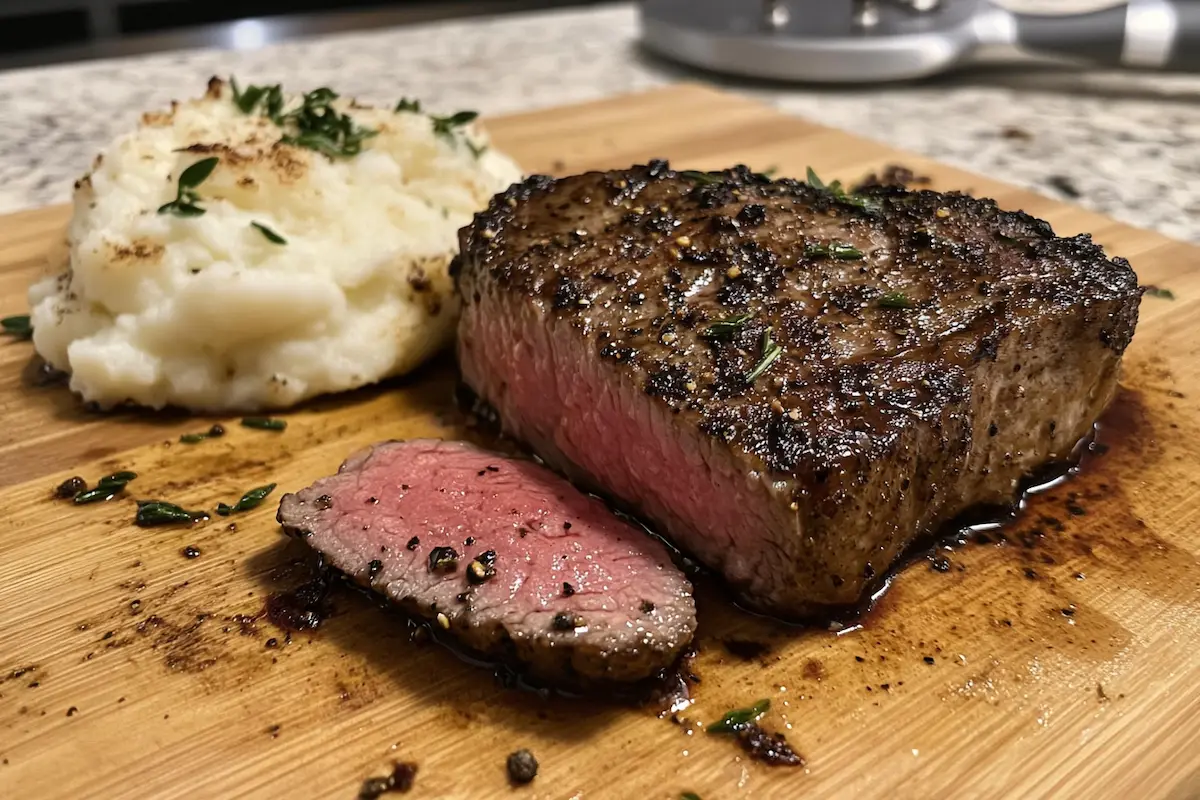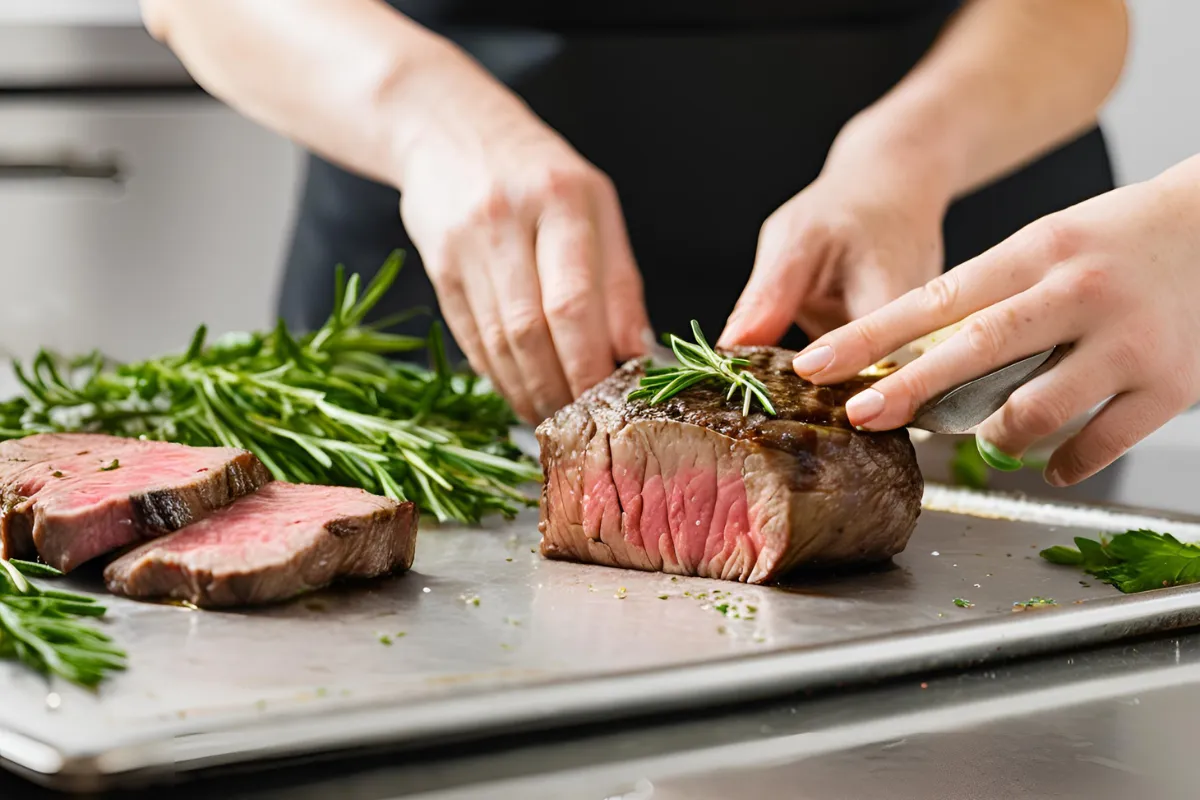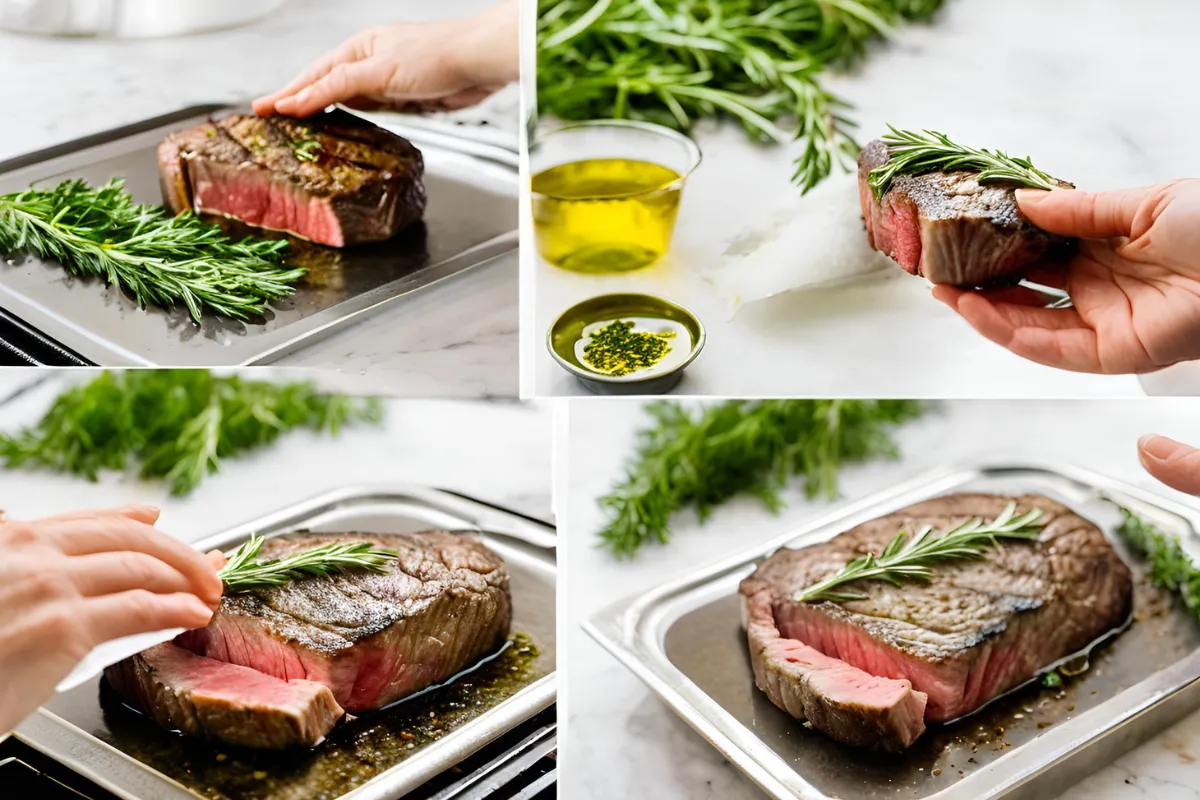Introduction
Do you cover filet mignon in the oven? It’s a common question that many home cooks face when preparing this premium cut of meat. Filet mignon is delicate and requires careful attention to get just right. Should you cover it to lock in moisture, or leave it uncovered to allow it to crisp up?
What is Filet Mignon and Why Does it Need Special Attention?
Filet mignon is undoubtedly one of the most beloved cuts of beef. Known for its tenderness, rich flavor, and melt-in-your-mouth texture, it’s a steak that commands attention. But there’s a reason why it requires more care than your average steak—it’s delicate. The muscle from which filet mignon is cut doesn’t get much use, so it’s naturally lean and soft. While that’s great news for tenderness, it also means the cooking process is a bit trickier.
When preparing filet mignon, the goal is to preserve its tenderness while ensuring it’s cooked perfectly. Unlike tougher cuts, filet mignon thrives with high-heat methods like searing and roasting. Overcooking the meat can lead to a loss of its natural juiciness. Some wonder if covering the steak during cooking might help retain moisture.
However, there’s more to consider. Filet mignon has very little fat, which is why it cooks faster than other steaks. This means you need to balance keeping it juicy and developing a tasty crust. Whether to cover the steak or leave it uncovered depends on factors like cooking time and oven temperature.
Understanding the delicate nature of filet mignon will help you decide whether to cover it during cooking. The wrong technique can turn a perfectly good steak into a dry, overcooked mess.
Why Filet Mignon Needs Special Attention
When it comes to premium cuts of beef, filet mignon is in a class of its own. But, because of its delicate nature, it requires a thoughtful approach to cooking. Unlike tougher cuts, filet mignon doesn’t have much connective tissue or fat to break down during cooking, which means it’s incredibly tender, but also more vulnerable to overcooking. Let’s take a closer look at why filet mignon demands special attention and how heat plays a critical role in its preparation.
Understanding the Delicate Nature of Filet Mignon
The unique texture of filet mignon makes it stand out from other steaks. This cut comes from the tenderloin, a muscle that doesn’t get much exercise. As a result, it’s naturally softer and leaner than other cuts like ribeye or sirloin. While this means it’s easy to chew, it also means there’s less fat to keep the meat juicy during cooking.
Since filet mignon is so lean, it’s important not to dry it out. The lack of fat means there’s less natural moisture in the meat, so if you cook it for too long, you risk ending up with a dry, tough steak. That’s why understanding how to control the cooking environment—whether by searing, baking, or covering the steak—is essential. Every step, from seasoning to the cooking method, can make a big difference in the final result.
The Role of Heat in Cooking Filet Mignon
The key to cooking filet mignon perfectly lies in the way heat interacts with the meat. High-heat methods like pan-searing or oven-roasting are ideal for this cut because they help seal in the juices, create a flavorful crust, and maintain the tenderness. The heat causes the proteins in the meat to contract, but because filet mignon is so lean, it cooks through quickly.
However, heat is a double-edged sword. Too much heat can cause the meat to dry out, and if the temperature is too low, the steak won’t develop the perfect sear. This delicate balance requires careful monitoring of the temperature to ensure the steak remains juicy while achieving that golden-brown exterior. The ideal oven temperature for cooking filet mignon is usually between 375°F and 400°F, which allows the steak to cook evenly without drying out.
Challenges of Overcooking or Undercooking Filet Mignon
The biggest challenge when cooking filet mignon is finding that sweet spot—cooking it enough to reach the perfect level of doneness without crossing the line into overcooked territory. Overcooking a filet mignon steak can ruin its naturally tender texture and turn it into a dry, tough piece of meat. This is especially true if you’re cooking it for too long at a high temperature.
Undercooking, on the other hand, may leave you with a steak that’s too rare for some tastes, which can be tricky to get just right. While some people enjoy filet mignon rare or medium-rare, the lean nature of the meat means it doesn’t have the same ability to stay tender and juicy at these lower temperatures as fattier cuts do. Therefore, it’s important to aim for that perfect level of doneness where the meat is cooked through but still retains its moisture.
Ultimately, filet mignon requires a precise cooking technique and timing. Too little heat or too much heat can leave you with a disappointing result.
Should You Cover Filet Mignon in the Oven?
When it comes to cooking filet mignon in the oven, the question of whether to cover it or not can stir up quite a debate. There are various schools of thought on this, and the right choice often depends on your cooking goals. In this section, we’ll break down the traditional method of cooking filet mignon uncovered, examine the pros and cons of covering it, and explore the circumstances under which you should consider either option. We’ll also discuss how oven temperature influences your decision to cover the steak or leave it exposed to direct heat.
The Traditional Method
Traditionally, filet mignon is cooked in the oven without a cover. This approach allows the meat to develop a nice, crisp, caramelized crust on the outside while retaining its natural juices inside. The high heat from the oven is absorbed by the surface of the steak, creating a golden-brown sear, which is often considered one of the best features of this cut. Leaving the steak uncovered also helps ensure that the steak cooks evenly, as air circulates around it, promoting an even distribution of heat.
Many professional chefs and home cooks alike prefer this method because it allows the steak’s natural flavors to shine through without any interference from trapped moisture. If you want that signature crispy, well-browned exterior with a juicy interior, cooking filet mignon uncovered is the way to go. Plus, it’s simple and doesn’t require much effort.
The Pros of Covering Filet Mignon
Despite the traditional approach, there are definite advantages to covering filet mignon during the cooking process, especially for those who want a different texture or finish. One of the main benefits of covering the steak is moisture retention. By covering the filet mignon, the steak is essentially steamed, which can help prevent it from drying out. This can be particularly useful if you’re cooking your steak at a lower temperature or for a longer time, where it’s easy to lose moisture.
Another advantage of covering is that it can help the steak cook more evenly. The cover traps the heat and prevents the outer layers from browning too quickly, which can allow the meat to cook more uniformly from edge to center. If you’re aiming for a more consistent doneness throughout the steak, covering it can help achieve that result. For individuals who are worried about over-browning the meat or developing a tough exterior, covering can be a good choice.
Lastly, covering the steak can help in retaining some of the flavorful aromatics, such as herbs or garlic, which you may be cooking alongside the filet mignon. The lid traps these smells and oils, infusing them into the steak and enhancing the overall flavor profile.
The Cons of Covering Filet Mignon
While there are some clear advantages to covering filet mignon, it does come with a few drawbacks. One of the biggest concerns is that covering the steak could result in the loss of that desirable crisp exterior. The trapped moisture turns to steam, softening the surface of the steak and reducing the chance of achieving a beautiful sear. This means that while your filet mignon may cook evenly and stay moist, it may lose some of the appealing texture that makes it so special.
Additionally, if the steak is covered for too long, you run the risk of creating a rather “steamed” steak rather than the beautifully roasted, caramelized version that many steak lovers crave. The longer you keep it covered, the more moisture the steak will accumulate, which can result in a less-than-ideal texture.
When to Cover and When Not to Cover Filet Mignon
Knowing when to cover filet mignon versus when to leave it uncovered comes down to your desired outcome. If you’re after a crisp, seared exterior with a juicy interior, the traditional uncovered method is your best bet. However, if you’re looking for a more even cook, or you’re preparing a thicker cut of filet mignon that might take longer to cook, covering the steak may help ensure that the meat remains tender and doesn’t dry out.
For example, if you’re baking your filet mignon at a lower temperature (around 325°F) for an extended period, covering the steak can help maintain moisture and prevent overcooking. But if you’re using higher temperatures (around 375°F or 400°F), it’s often better to leave it uncovered to allow the surface to brown and crisp up.
Oven Temperature and Its Effect on Cooking
The temperature at which you cook filet mignon plays a crucial role in determining whether or not to cover it. High oven temperatures (around 400°F) are ideal for cooking steaks uncovered. This heat allows for quick searing of the outside while preserving the moist, tender interior. When cooking at this high heat, you want to allow the steak to cook in the open air to achieve that perfect crust.
On the other hand, if you’re using a moderate oven temperature (between 325°F and 350°F), covering the steak can help preserve moisture while the steak cooks more slowly, ensuring an evenly cooked and tender result. This method is often used when you’re looking to create a steak that is more evenly cooked from edge to center, with less of a contrast between the crispy outer layer and the tender middle.
Ultimately, the decision to cover or not to cover filet mignon in the oven depends on your preferred cooking method, oven temperature, and desired results.
Cooking Tips for Perfect Filet Mignon
Cooking filet mignon to perfection can seem like a daunting task, but with the right techniques, it’s easier than you might think. Whether you’re a beginner or an experienced cook, following the best practices can elevate your steak game. Let’s break down some key tips for preparing a perfectly cooked filet mignon that will leave your guests raving.
Searing the Filet Mignon Before Oven Cooking
One of the most important steps when preparing filet mignon is searing it on the stovetop before transferring it to the oven. Searing at high heat creates a beautifully browned, caramelized crust that locks in the flavors and juices. This is particularly important for cuts like filet mignon, which are lean and require some external fat to enhance the flavor.
Start by heating a heavy skillet, preferably cast iron, over medium-high heat. Add a bit of oil with a high smoke point, such as vegetable or canola oil. When the oil is shimmering, place the filet mignon in the pan. Sear each side for about 2–3 minutes, or until it’s golden brown. The goal is to create a nice crust without cooking the steak through. After searing, immediately transfer the steak to the preheated oven to finish cooking.
This method gives you the best of both worlds: the rich flavor from the sear and the even cooking from the oven. Skipping the searing step can lead to a less flavorful steak with an uneven crust.
How Long to Cook Filet Mignon in the Oven
Cooking times for filet mignon can vary depending on the thickness of the steak and the desired level of doneness. However, there are some general guidelines that can help you get it just right. Below are typical cooking times for a 1.5-inch thick filet mignon when baking at 400°F:
- Rare: 4-5 minutes in the oven (120–125°F internal temperature)
- Medium-rare: 5-6 minutes (130–135°F internal temperature)
- Medium: 6-7 minutes (140–145°F internal temperature)
- Medium-well: 8-9 minutes (150–155°F internal temperature)
- Well-done: 10-12 minutes (160°F and above)
Remember, the steak will continue to cook slightly as it rests, so aim for a temperature that’s a few degrees lower than your desired final temperature.
How to Check Doneness Without Cutting Into the Meat
No one wants to ruin a beautiful filet mignon by cutting into it to check the doneness. Fortunately, there’s a simple way to do this without sacrificing the juiciness of the meat. Using a meat thermometer is the most accurate method. Insert the thermometer into the side of the steak, making sure it doesn’t touch bone or fat. When it reaches the target temperature, you’re good to go!
If you don’t have a thermometer, you can also use the “touch test.” Gently press on the steak with your finger and feel the firmness. The firmer it feels, the more well-done the steak is. Softness indicates a rare to medium-rare steak. This method takes practice but can be a useful skill when you don’t have a thermometer on hand.
Resting Time After Cooking
Resting is crucial for maintaining the filet mignon‘s tenderness and juiciness. After removing the steak from the oven, let it rest on a cutting board or plate for at least 5 minutes before serving. This allows the juices, which have been driven to the center of the meat during cooking, to redistribute throughout. Cutting into the steak too soon will cause these juices to spill out, leading to a less flavorful and drier steak.
Cover the steak loosely with foil while it rests to keep it warm without trapping too much moisture.
Basting or Butter Techniques for Extra Flavor
For extra richness, baste your filet mignon with butter and herbs while cooking in the oven. Melt butter in a skillet. Add garlic, thyme, rosemary, or other herbs of your choice. Once the steak is in the oven, baste it every 5 minutes with the melted butter. This infuses the meat with flavors and keeps it moist.
Alternatively, after searing the steak, add a dollop of herb-infused butter on top. Finish cooking in the oven. The butter will melt over the steak, adding richness to the dish.
By following these tips—searing, checking doneness, resting, and adding butter—you’ll cook the perfect filet mignon every time.
Frequently Asked Questions (FAQs)
When it comes to cooking filet mignon, many home cooks have similar questions about the best methods, timing, and techniques. Here are answers to some of the most common questions people ask when preparing this delicious cut of meat.
Is It Better to Sear Filet Mignon Before or After Baking?
Searing filet mignon before baking is highly recommended. This step helps create a flavorful, crispy crust on the outside while locking in the meat’s natural juices. By quickly searing the steak on the stovetop over high heat, you’re caramelizing the proteins and fats, which adds rich flavor. After searing, transferring the steak to the oven allows for even cooking without drying it out. Skipping the sear can lead to a less flavorful crust and uneven texture.
Should You Use a Meat Thermometer for Filet Mignon?
Yes, using a meat thermometer is the most accurate way to check the doneness of filet mignon. This ensures that the steak is cooked to your desired level without cutting into it and losing precious juices. Insert the thermometer into the side of the steak, avoiding bones or fat, for the best results. This method helps you get the perfect filet mignon every time.
What Are the Best Sides to Serve with Filet Mignon?
Filet mignon pairs beautifully with simple, elegant sides that complement its rich flavor. Consider serving it with creamy mashed potatoes, roasted vegetables like asparagus or Brussels sprouts, or a fresh salad with a light vinaigrette. A rich sauce, such as béarnaise or a red wine reduction, also pairs wonderfully with this tender cut.
Should I Cover Filet Mignon When Cooking?
Whether you should cover filet mignon while cooking in the oven depends on your desired result. If you want to retain moisture and cook the steak more evenly, covering it lightly with foil can help. However, if you’re aiming for a crisp, caramelized crust, it’s best to leave the steak uncovered. Each method has its advantages, so choose based on your preferences.
How Long to Bake Filet Mignon at 400 in the Oven?
Baking filet mignon at 400°F typically takes 5-7 minutes for medium-rare, depending on the thickness of the steak. For a 1.5-inch steak, check the internal temperature with a thermometer to ensure you’ve reached your preferred level of doneness.
Should You Cover Steak with Foil in the Oven?
Covering steak with foil in the oven can help keep it moist, but it may also prevent the steak from developing a nice crust. For filet mignon, it’s usually better to leave it uncovered to get that golden-brown sear. If you prefer a softer texture or need to slow-cook, then lightly covering the steak may be useful.
How Does Gordon Ramsay Cook Filet Mignon in the Oven?
Gordon Ramsay typically uses a high-heat sear followed by oven roasting. He sears the steak in a hot pan for 2-3 minutes on each side to develop a beautiful crust, then finishes it off in a preheated oven at 400°F. He recommends basting the steak with butter and herbs for added flavor, and always checks the doneness with a meat thermometer.
Conclusion: Do You Cover Filet Mignon in the Oven?
Cooking filet mignon to perfection is both an art and a science. Understanding its unique nature is key. This tender, lean cut of beef requires precision. Whether searing, baking, or deciding to cover it in the oven, every step matters. Should you cover filet mignon? It depends on your desired outcome. If you want a moist, evenly cooked steak, cover it lightly with foil. If you want a flavorful, caramelized crust, leave it uncovered. The choice depends on balancing moisture with texture.
The best way to cook filet mignon involves a high-heat sear and controlled oven roasting. A meat thermometer prevents overcooking this delicate cut. Resting the steak after cooking helps preserve its juiciness. Techniques like basting with butter and herbs enhance flavor and create a restaurant-quality steak.
Achieving the perfect filet mignon is about experimentation. Don’t be afraid to try different methods. Adjust based on your preferences. Whether rare, medium, or well-done, the right combination of searing, seasoning, and roasting works wonders. With a little practice, you’ll master cooking filet mignon. It’s time to grab your apron and get cooking!



